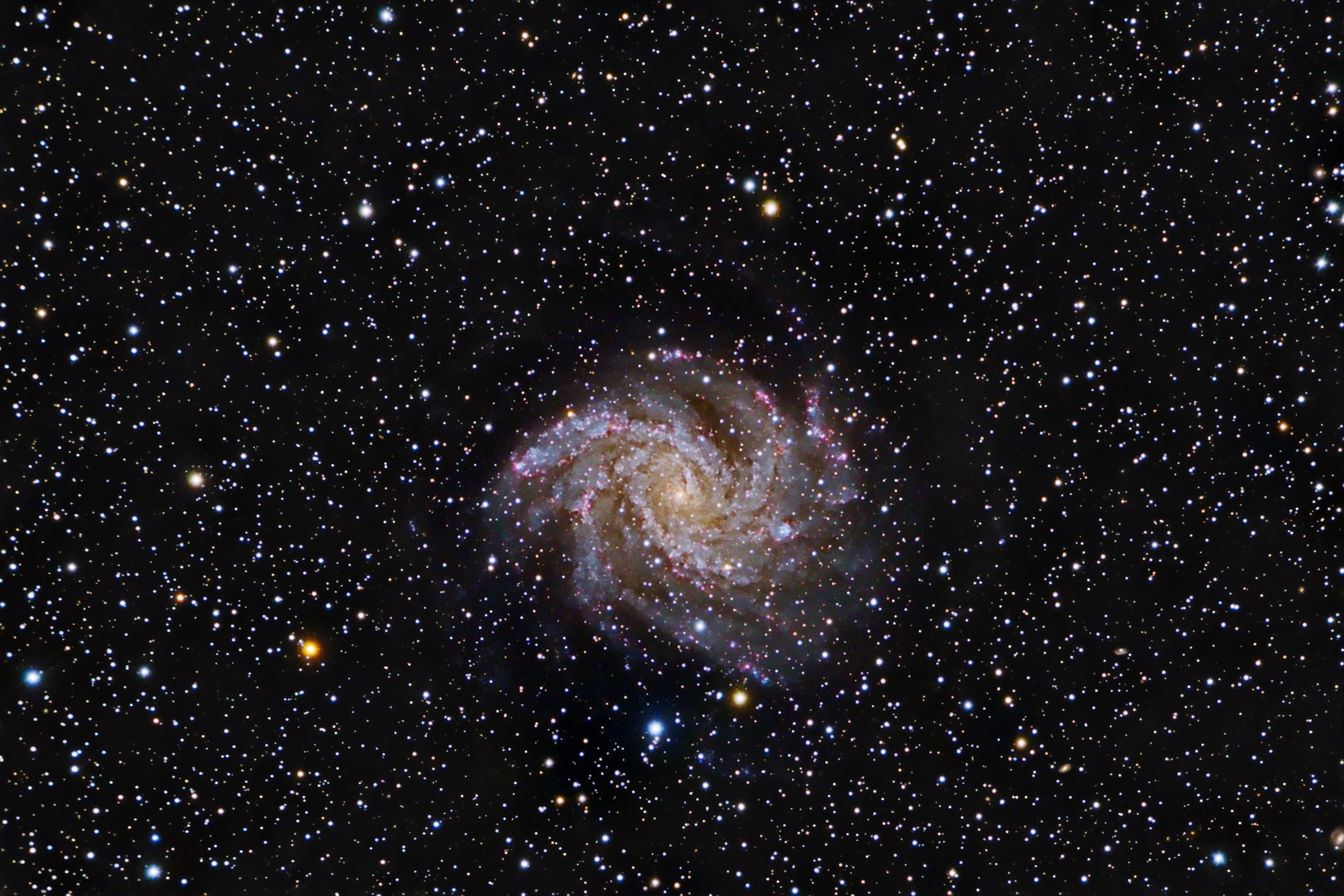Object name: ARP029 Arp 29 is far better known as NGC 6946, the Fireworks Galaxy. This is because it is undergoing massive star formation and close enough that we can easily resolve many of the HII regions as well as a massive star cluster. The cluster is well resolved in the upper left corner of the Gemini North image. http://antwrp.gsfc.nasa.gov/apod/ap050125.html My image scale and seeing weren't sufficient to fully resolve it so only a few of the stars show with the rest forming what appears to be a blue reflection nebula. Note the Gemini image has south up while mine is north up. Another reason for its common name is all the supernova that have been seen blowing in it. The last was in 2008. NED list 9 known supernovae in this galaxy; SN 1917A, N 1939C, SN 1948B, SN 1968D, SN 1969P, SN 1980K, SN 2002hh, SN 2004et and SN 2008S. 27 supernova remnants are also known in this galaxy according to NED.
But none of this is the reason it is in Arp's catalog. He included it under Spiral galaxies with one heavy arm. Some in this category have a rather obvious heavy arm but here I'm not even sure which arm he is speaking of. Maybe it's the one to the northeast (upper left) of the core in my image. Though his comment addressed the supernovas saying "Supernova once observed in tip of thick arm." This may refer to the 1948 supernova though it was well back of what I'd call the "tip" of the eastern arm. Though closer to the end than those appearing in other arms.
Every paper I found shows a different distance to this obviously nearby galaxy. In fact, two different papers analyzed the 1980 supernova and came up with wildly different distance estimates! One decided it was 18.5 million light-years away, the other over 41 million light-years. One or both are very wrong. The APOD link above says 10 million light-years, closer than any paper I found. So I'll give the wide range of about 10 to 20 million light-years as its distance. This galaxy is in the Milky Way and thus heavily obscured. This likely complicates distance estimates. It certainly is close enough for Cepheid variables to be seen but unless the dust between us and the galaxy is accurately known the distance becomes uncertain. I suspect it is differences in dust estimates that account for much of the uncertainty of the distance to this galaxy.
I should have taken far more data on this one. I see a hint of a long blue arm going north. The field is full of clouds. Some so close to the galaxy I can't tell if they are pieces of the galaxy or pieces of junk in our galaxy. Most likely in ours. Note the area just along the western edge of Arp 29 that has no stars, just a faint fuzzy patch. A brighter but smaller one below it doesn't seem to obscure stars. I see no reason to question my flats so suspect these clouds are real. But they are right at the noise level. Something a lot more time would certainly help decide.
The galaxy was discovered by William Herschel on September 9, 1798 and is in the original Herschel 400 program. My notes from May 21, 1985 on a very good night with my 10" f/5 at up to 180x reads "Large, obviously face on spiral. Structure in arms very easy to see tonight. In fact, it is a rival to M-51 for ease in seeing the spiral structure. It nearly fills the field at 120x and is a fantastic sight tonight."
I had a gaggle of satellites go through the images. I tried to clone them out -- with only 4 images any noise rejection I tried also added noise -- and hope I didn't add any artifacts doing so. I'm sure a few stars in our galaxy got erased, however. But there are so many in this field we can spare a few. So many they really blew up the JPEG size of this image.
There are a few other galaxies in the image and one missing one. NED lists a 15.6 magnitude galaxy, [OBC97] N05-1 at the top of my image that should be easily visible but there's nothing there. Those easiest to find are all south-west of Arp 29. The one hiding behind a star is 2MASX J20332396+6005088. Below and east (left) of it is the slightly bigger and brighter 2MASX J20333573+6002118. Neither have any other data, unfortunately. The same lack applies to 2MASX J20324060+6000181 in the very southwest corner of my image. I didn't quite catch all of it. You'd think one this big and bright would at least have a magnitude estimate but nothing. Guess the 2MASS survey didn't want to detract from the fireworks of Arp 29.
Arp's image with the 200" is at:
http://ned.ipac.caltech.edu/level5/Arp/Figures/big_arp29.jpeg
He was pushing the field corrector to its limits with the wide field needed to cover this one. Note the distorted stars at the corners.
14" LX200R @ f/10, L=4x10' RGB=2x10'x3, STL-11000XM, Paramount ME Related Designation(s):11HUGS 410, 2MASX J20345233+6009132, 2XMM J203452.4+600912, 2XMMp J203452.4+600912, 87GB 203349.0+595856, 87GB[BWE91] 2033+5958, 8C 2033+599, ARP 029, ARP029, CGCG 2033.8+5959, CGCG 304-006, CXO J203452.3+600914, CXO J203452.33+600914.3, Fireworks, FVW G095.5+11.5, HDCE 1123 NED001, IRAS 20338+5958, IRAS F20338+5958, LDCE 1412 NED003, MCG +10-29-006, NGC 6946, NGC 6946:[FT87] 1, NGC 6946:[L2011a] X0021, NGC 6946:[LB2005] X01, NGC 6946:[RW2000] X-06, NVSS J203452+600916, PGC 065001, RGB J2034+601, RX J2034.9+6010, UGC 11597, UZC J203452.8+600911, [HRT2007] J203452+600927, [SGT2004] J203452.30+600911.7 , [SPB93] 263, [WB92] 2033+5958, | | 